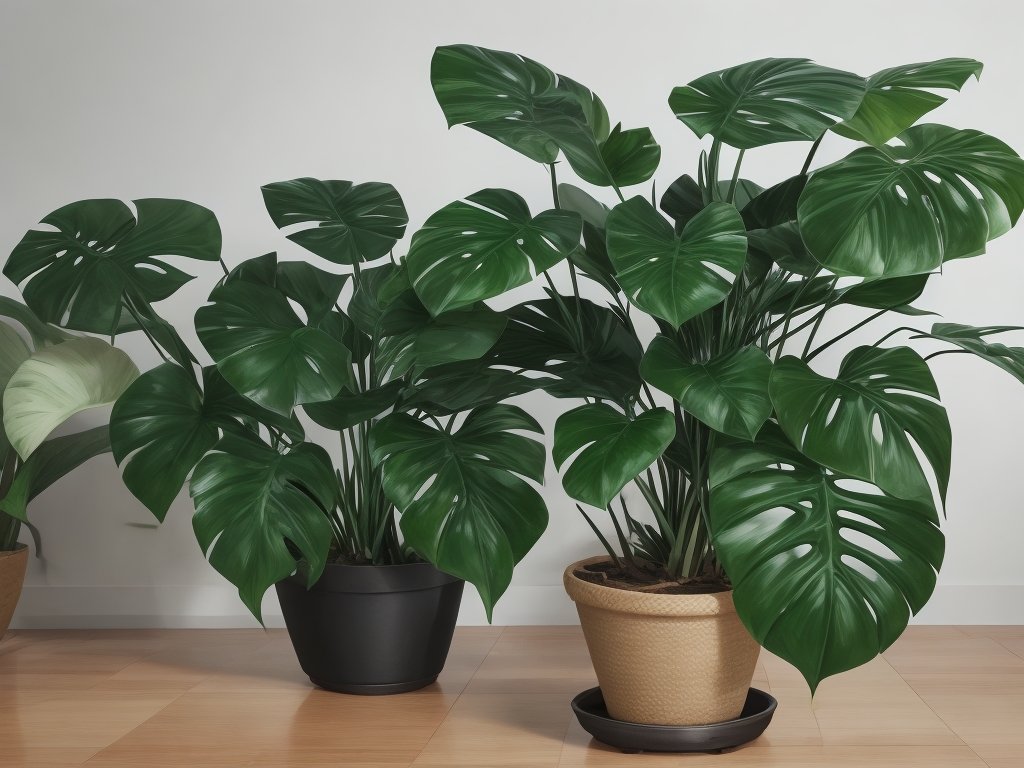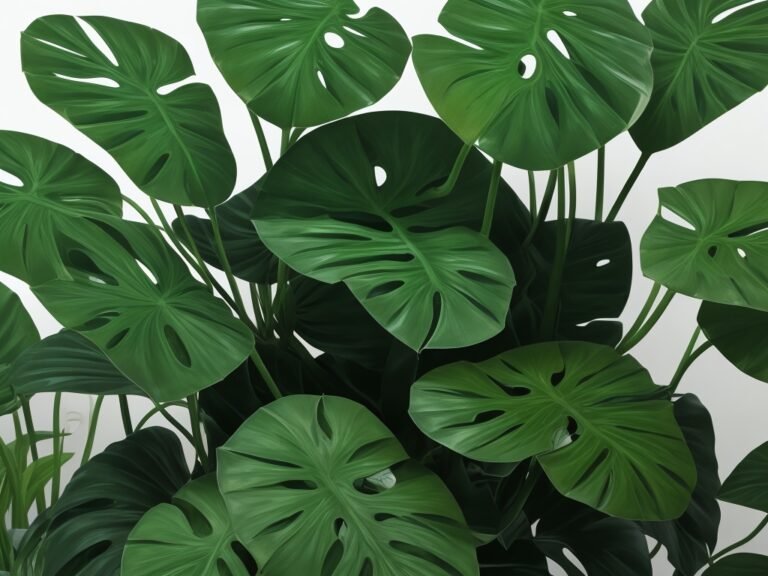Why Did All The Leaves Fall Off My Monstera Plant?
Key Takeaways:
- Overwatering can cause leaves to fall off a Monstera plant.
- Insufficient light can also lead to leaf loss in Monstera plants.
- Nutrient deficiencies may contribute to leaf drop in Monstera plants.
- Pests or diseases can be another reason for leaves falling off Monstera plants.
Have you ever walked into a room, only to find that all the leaves have fallen off your beloved Monstera plant?
It can be quite disheartening to see your once luscious and thriving plant suddenly bare.
But fear not, my fellow plant parent! In this article, we will delve into the mysteries of the Monstera plant and explore why it might shed its leaves.
From understanding seasonal changes to identifying environmental factors and common care mistakes, we’ll cover it all.
So, sit back, relax, and let’s get to the root of this leafy dilemma!
| Possible Reasons: |
| Lack of Water |
| Overwatering |
| Low Humidity |
| Low Light Conditions |
| Temperature Stress |
| Nutrient Deficiencies |
| Root Rot |
Understanding the Monstera Plant
The Monstera Plant is a popular and unique houseplant that is known for its large, glossy leaves and beautiful vining growth habit. It is native to tropical regions of Central and South America.
What is a Monstera Plant?
A Monstera plant is a tropical vine native to Central and South America.
It’s known for its large, glossy leaves with natural leaf holes, which give it a unique and distinctive appearance.
Monstera plants are popular as indoor houseplants due to their attractive foliage and relatively low maintenance requirements.
They can add a touch of tropical beauty to any space.

Characteristics of a Monstera Plant
A Monstera plant, also known as a Swiss cheese plant, is a popular houseplant with large, glossy, heart-shaped leaves. It is known for its unique fenestrations or holes in the leaves, which are characteristic of mature plants.
Monstera plants are climbers and can grow tall if provided with proper support.
They thrive in bright indirect light and prefer well-draining soil. These plants are relatively easy to care for and make a stunning addition to any indoor space.

Common Care Tips for Monstera Plants
Common care tips for Monstera plants include:
- Provide bright, indirect light. Avoid direct sunlight as it can scorch the leaves.
- Water thoroughly when the top inch of soil feels dry, then allow the soil to dry out slightly before watering again.
- Use well-draining soil to prevent root rot. A mix of peat moss, perlite, and potting soil works well.
- Maintain a humid environment by misting the leaves or placing the plant on a tray filled with pebbles and water.
- Feed the Monstera plant with a balanced fertilizer once a month during the growing season.
- Prune your Monstera plant to encourage bushier growth and remove any damaged or yellowing leaves.
Remember, each plant is unique, so observe your Monstera and adjust your care routine as needed.
Seasonal Changes and Leaf Drop
As seasons change, it’s normal for Monstera plants to shed leaves. Understanding this process and its environmental factors can help you differentiate between normal and abnormal leaf drop.
Normal Leaf Shedding in Monstera Plants
Normal leaf shedding in Monstera plants is a natural process. As the plant grows, older leaves gradually turn yellow and drop off.
This helps the plant conserve energy and focus on producing new, healthy leaves.
It’s important to differentiate between normal leaf shedding and abnormal leaf drop caused by factors like pests, diseases, or poor care. Regularly inspect your Monstera plant to ensure it’s healthy and thriving.
Understanding Seasonal Changes in Monstera Plants
Understanding seasonal changes in Monstera plants is important for their care.
Monstera plants naturally go through a shedding process where older leaves turn yellow or brown and fall off.
Environmental factors like temperature and daylight duration can influence this process.
Differentiating between normal and abnormal leaf drop is crucial in providing appropriate care.

Effects of Environmental Factors on Leaf Drop
Environmental factors such as temperature extremes, drafts, improper lighting, and humidity levels can cause leaf drop in Monstera plants.
Overwatering, lack of proper nutrition, and pest infestations can also contribute to leaf loss.
It’s important to provide suitable conditions and address any issues promptly to prevent excessive leaf drop.
How to Differentiate Between Normal and Abnormal Leaf Drop
Differentiating between normal and abnormal leaf drop in Monstera plants can be done by considering a few factors.
Firstly, normal leaf shedding occurs as part of the plant’s natural growth cycle, whereas abnormal leaf drop is often sudden and excessive.
Secondly, normal leaf shedding generally involves older, lower leaves, while abnormal leaf drop can affect leaves at any age or position on the plant.
Lastly, if the leaf drop is accompanied by other signs of stress such as discoloration, wilting, or visible damage, it may indicate an underlying issue that needs to be addressed.
Possible Reasons for Leaf Drop in Monstera Plants
Possible Reasons for Leaf Drop in Monstera Plants include overwatering, underwatering, lack of proper lighting, temperature extremes, nutrition deficiencies, pests and diseases, and incorrect pruning techniques.
Overwatering and Root Issues
Overwatering is a common issue that can lead to leaf drop in Monstera plants.
When the roots are constantly saturated, they can become waterlogged and begin to rot.
This can prevent the plant from absorbing oxygen and nutrients, causing stress and leaf loss.
It’s important to allow the top inch of soil to dry out before watering again to prevent overwatering.
Additionally, root issues such as root rot or damage can also contribute to leaf drop.
Regularly inspect your plant’s roots for any signs of rot or damage, and if necessary, repot your Monstera in fresh, well-draining soil.
Underwatering and Drought Stress
Underwatering and drought stress are common reasons for leaf drop in Monstera plants.
When the plant doesn’t receive enough water, its leaves can wilt, turn yellow, and eventually fall off.
It’s important to ensure that you are watering your Monstera plant properly and providing it with the right amount of moisture.
If you notice dry soil or if the leaves are starting to droop, it’s time to give your plant a drink.
Avoid overwatering as well, as this can also lead to leaf drop.
Lack of Proper Lighting
Lack of proper lighting is a common reason for leaf drop in Monstera plants. These plants require bright, indirect light to thrive.
Insufficient light can weaken the plant, leading to yellowing and shedding of leaves.
To prevent this, place your Monstera in a well-lit area, away from direct sunlight which can scorch its leaves. Consider using artificial grow lights if natural light is limited.
Temperature Extremes and Drafts
Temperature extremes and drafts can be detrimental to Monstera plants. Extreme heat or cold can cause stress and leaf drop.
Avoid placing your plant near heating or cooling vents, and keep it away from drafty windows or doors.
Maintain a consistent temperature and avoid sudden fluctuations.
Nutrition and Fertilizer Deficiencies
Nutrition and fertilizer deficiencies can lead to leaf drop in Monstera plants. Lack of essential nutrients like nitrogen, phosphorus, and potassium can weaken the plant and cause it to shed leaves.
Providing a balanced fertilizer specifically formulated for indoor plants can help prevent deficiencies and keep your Monstera healthy.
Pests and Diseases
Pests and diseases can cause leaf drop in Monstera plants.
Common pests include spider mites, mealybugs, and scale insects.
These pests can suck sap from the leaves, leading to leaf discoloration and eventual drop.
Fungal diseases like root rot can also result in leaf drop.
Regular inspection and prompt treatment are important to prevent and control these issues.
Incorrect Pruning Techniques
Incorrect pruning techniques can lead to leaf drop in Monstera plants.
Some common mistakes include pruning too much at once, cutting the stems too close to the main branch, and removing healthy leaves.
It’s important to prune selectively, cutting back only dead or damaged foliage, and leaving enough healthy leaves to support the plant’s growth.
How to Prevent Leaf Drop in Monstera Plants
To prevent leaf drop in your Monstera plant, focus on maintaining proper watering habits, providing adequate lighting conditions, considering temperature and humidity, ensuring proper nutrition and fertilization, identifying and treating pests and diseases, and using pruning techniques to promote healthy growth.
Maintaining Proper Watering Habits
To maintain proper watering habits for your Monstera plant, it’s important to find the right balance. Here are a few tips:
- Water your plant when the top inch of soil feels dry to the touch.
- Avoid overwatering, as this can lead to root rot and leaf drop.
- Ensure proper drainage in the pot to prevent water from sitting in the soil.
- Use a well-draining potting mix that allows excess water to flow through.
- Water thoroughly until the water drains out the bottom of the pot, then empty the saucer.
- Consider factors like humidity, temperature, and the plant’s growth stage when determining watering frequency.
- Monitor your plant’s response to watering and adjust accordingly. Remember, each plant is unique, so it may take some time to find the ideal watering routine.
Providing Adequate Lighting Conditions
A Monstera plant needs bright, indirect light to thrive. Place it near a window with filtered sunlight, or use a sheer curtain to diffuse direct sunlight.
Avoid exposing it to intense, direct sunlight as it can scorch the leaves.
Regularly rotate the plant to ensure even growth.
Temperature and Humidity Considerations
Maintaining appropriate temperature and humidity levels is essential for the health of your Monstera plant. Aim for a temperature range of 65-85°F (18-29°C) and relative humidity between 40-60%.
Avoid extreme temperature fluctuations and drafts, as they can stress the plant.
Consider using a humidifier or pebble tray to increase humidity. Monitor and adjust conditions accordingly.
Proper Nutrition and Fertilization
Proper nutrition and fertilization are essential for the health and vitality of your Monstera plant. Here’s what you need to know:
- Use a well-balanced fertilizer specifically formulated for houseplants, and follow the instructions on the package.
- Fertilize your Monstera during the growing season (spring and summer when it’s actively producing new leaves.
- Avoid overfertilizing, as this can lead to salt buildup and damage the roots.
- Consider using a slow-release fertilizer or organic options like compost or worm castings for a more gradual and sustainable release of nutrients.
- Monitor your plant for any signs of nutrient deficiencies, such as yellowing leaves or stunted growth, and adjust your fertilization routine accordingly.
By providing your Monstera with the proper nutrients, you’ll help it thrive and reduce the risk of leaf drop.
Identifying and Treating Pests and Diseases
Identifying pests and diseases in Monstera plants is crucial for their health. Look for signs of common pests like spider mites, mealybugs, and aphids.
Treat them with organic insecticidal soap or neem oil.
Diseases like root rot and powdery mildew require proper sanitation and fungal treatments. Regularly inspect your plants and take action promptly to keep them healthy.
Pruning Techniques to Promote Healthy Growth
To promote healthy growth in your Monstera plant, pruning is essential. Here are some pruning techniques you can follow:
- Remove dead or damaged leaves: Regularly inspect your plant and remove any leaves that are yellowing, brown, or wilted. This helps redirect energy to healthier parts of the plant.
- Trim leggy stems: If your Monstera is becoming too leggy or top-heavy, trim back the long stems to encourage bushier growth. Make clean cuts just above a leaf node to promote new growth.
- Control size: If your Monstera is outgrowing its space, you can prune back the main stem to a desired height. Cutting just above a leaf node will prompt new growth from that point.
- Prune for shape: If your Monstera is growing unevenly or in an undesirable shape, you can selectively prune certain stems to create a more balanced and aesthetically pleasing appearance.
Remember to use clean, sharp pruning shears and always sanitize them before use. Pruning during the plant’s active growth period, typically in spring or summer, is ideal.
Frequently Asked Questions about Leaf Drop in Monstera Plants
Can Monstera Plants Regrow Lost Leaves?
Yes, Monstera plants have the ability to regrow lost leaves. As long as the plant is healthy and provided with proper care, it can produce new leaves to replace the ones that have fallen off.
Regular watering, adequate lighting, and a balanced fertilizer schedule can help promote leaf regeneration in Monstera plants.
What should I do if all the leaves have fallen off my Monstera plant?
If all the leaves have fallen off your Monstera plant, don’t panic! Start by assessing the plant’s care conditions.
Check for overwatering or underwatering, ensure proper lighting and temperature levels, provide adequate nutrition, and look out for pests and diseases.
Make necessary adjustments and give your plant time to recover.
How long does it take for a Monstera plant to regrow its leaves?
Monstera plants typically take several weeks to several months to regrow their leaves. The exact timing depends on various factors, such as the plant’s overall health, growing conditions, and the severity of leaf loss.
It’s important to provide the plant with optimal care and address any underlying issues to help speed up the regrowth process.
Patience and consistent care are key when waiting for your Monstera to bounce back with new leaves.
Can overwatering cause leaf drop in Monstera plants?
Yes, overwatering can cause leaf drop in Monstera plants.
When the roots are constantly saturated, they become deprived of oxygen and can begin to rot.
This ultimately affects the plant’s ability to absorb nutrients and leads to leaf drop.
It’s important to find the right balance and only water when the top inch of soil is dry.
Are Monstera plants prone to particular pests or diseases?
Monstera plants are generally quite resilient and resistant to pests and diseases.
However, they can still be susceptible to a few common issues.
Some pests that may affect Monstera plants include spider mites, mealybugs, and scale insects.
Diseases such as root rot and leaf spot can also occur.
Regular inspection and proper care can help prevent and address these problems.
Final Verdict
Understanding the reasons behind leaf drop in Monstera plants is crucial for their care and well-being. While some amount of leaf shedding is normal, it’s important to distinguish between normal and abnormal leaf drop.
Factors such as overwatering, underwatering, lack of proper lighting, temperature extremes, nutrition deficiencies, pests, diseases, and incorrect pruning can all contribute to leaf drop.
By maintaining proper watering habits, providing adequate lighting and temperature conditions, ensuring proper nutrition, identifying and treating pests and diseases, and employing correct pruning techniques, you can prevent leaf drop and promote healthy growth in your Monstera plants. Remember, patience is key as it may take some time for your plant to regrow lost leaves.
With proper care, your Monstera plant will thrive and bring beauty to your space.






